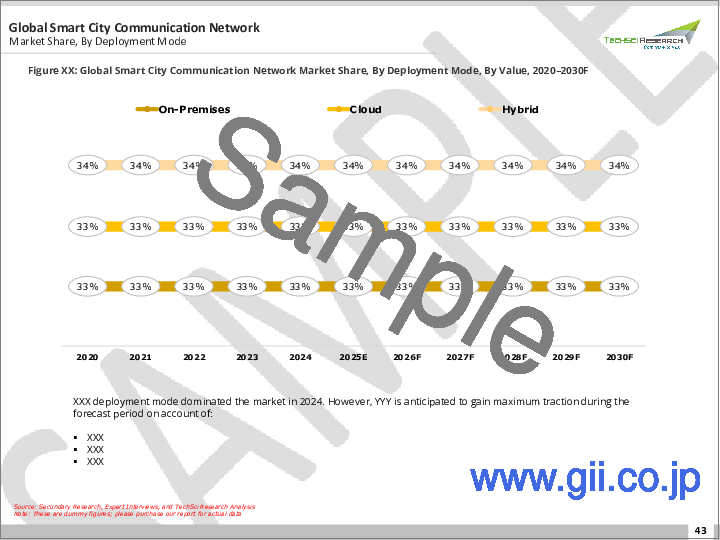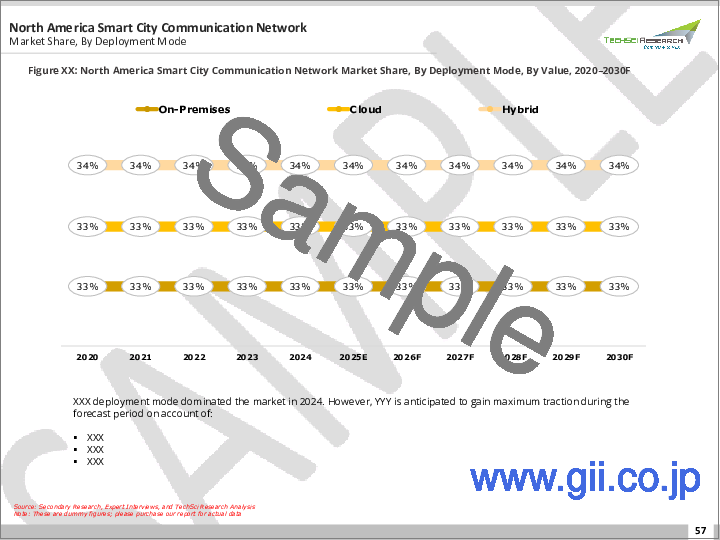|
|
市場調査レポート
商品コード
1764115
スマートシティ通信ネットワーク市場-世界の産業規模、シェア、動向、機会、予測、タイプ別、用途別、地域別、市場競合、2020~2030年Smart City Communication Network Market - Global Industry Size, Share, Trends, Opportunity, and Forecast, By Type, By Application, By Region & Competition, 2020-2030F |
||||||
カスタマイズ可能
|
|||||||
| スマートシティ通信ネットワーク市場-世界の産業規模、シェア、動向、機会、予測、タイプ別、用途別、地域別、市場競合、2020~2030年 |
|
出版日: 2025年06月30日
発行: TechSci Research
ページ情報: 英文 185 Pages
納期: 2~3営業日
|
全表示
- 概要
- 目次
スマートシティ通信ネットワークの世界市場規模は、2024年に3,260億米ドルとなり、2030年には8,180億米ドルに達すると予測され、予測期間中のCAGRは16.56%で成長すると予測されています。
この市場には、スマートシティ環境内のシステム、デバイス、アプリケーション間のシームレスでリアルタイムかつ安全な通信を可能にする統合デジタルインフラが含まれます。交通システム、エネルギーグリッド、モニタリング、公共サービス、市民インターフェースをサポートするデジタルコアとして機能します。5G、光ファイバー、低電力広域ネットワーク、クラウドプラットフォームなどの技術を搭載したこれらのネットワークにより、都市はリソースを最適化し、安全性を高め、エネルギー使用を削減し、都市生活を向上させることができます。同市場は、急速な都市化、政府の支援施策、インテリジェント都市管理に対する需要の高まりにより、強い勢いを見せています。5Gとエッジコンピューティングの登場により、ネットワークの性能、拡大性、応答性がさらに強化され、スマートシティ通信ソリューションの採用が世界的に加速しています。
| 市場概要 | |
|---|---|
| 予測期間 | 2026~2030年 |
| 市場規模:2024年 | 3,260億米ドル |
| 市場規模:2030年 | 8,180億米ドル |
| CAGR:2025~2030年 | 16.56% |
| 急成長セグメント | 小規模都市 |
| 最大市場 | 北米 |
市場促進要因
都市化とインフラのデジタル化需要
主要市場課題
サイバーセキュリティとデータプライバシーの脆弱性
主要市場動向
人工知能と通信インフラの統合
目次
第1章 ソリューション概要
- 市場の定義
- 市場の範囲
- 対象市場
- 調査対象年
- 主要市場セグメンテーション
第2章 調査手法
第3章 エグゼクティブサマリー
第4章 顧客の声
第5章 世界のスマートシティ通信ネットワーク市場展望
- 市場規模・予測
- 金額別
- 市場シェア・予測
- タイプ別(光ファイバー、無線周波数、ハニカム、Wi-Fi、電力線通信、低電力広域ネットワーク)
- 用途別(小規模都市、大規模都市)
- 地域別(北米、欧州、南米、中東・アフリカ、アジア太平洋)
- 企業別(2024年)
- 市場マップ
第6章 北米のスマートシティ通信ネットワーク市場展望
- 市場規模・予測
- 市場シェア・予測
- 北米:国別分析
- 米国
- カナダ
- メキシコ
第7章 欧州のスマートシティ通信ネットワーク市場展望
- 市場規模・予測
- 市場シェア・予測
- 欧州:国別分析
- ドイツ
- フランス
- 英国
- イタリア
- スペイン
第8章 アジア太平洋のスマートシティ通信ネットワーク市場展望
- 市場規模・予測
- 市場シェア・予測
- アジア太平洋:国別分析
- 中国
- インド
- 日本
- 韓国
- オーストラリア
第9章 中東・アフリカのスマートシティ通信ネットワーク市場展望
- 市場規模・予測
- 市場シェア・予測
- 中東・アフリカ:国別分析
- サウジアラビア
- アラブ首長国連邦
- 南アフリカ
第10章 南米のスマートシティ通信ネットワーク市場展望
- 市場規模・予測
- 市場シェア・予測
- 南米:国別分析
- ブラジル
- コロンビア
- アルゼンチン
第11章 市場力学
- 促進要因
- 課題
第12章 市場動向と発展
- 合併と買収
- 製品上市
第13章 企業プロファイル
- Cisco Systems, Inc.
- IBM Corporation
- Siemens AG
- Huawei Technologies Co., Ltd.
- Nokia Corporation
- Telefonaktiebolaget LM Ericsson
- NEC Corporation
- Schneider Electric SE
第14章 戦略的提言
第15章 調査会社について・免責事項
The Global Smart City Communication Network Market was valued at USD 326 billion in 2024 and is projected to reach USD 818 billion by 2030, growing at a CAGR of 16.56% during the forecast period. This market encompasses the integrated digital infrastructure enabling seamless, real-time, and secure communication among systems, devices, and applications within a smart city environment. It functions as the digital core supporting traffic systems, energy grids, surveillance, public services, and citizen interfaces. Powered by technologies like 5G, fiber optics, low-power wide-area networks, and cloud platforms, these networks allow cities to optimize resources, enhance safety, reduce energy use, and improve urban living. The market is witnessing strong momentum due to rapid urbanization, supportive government policies, and growing demand for intelligent urban management. The emergence of 5G and edge computing further enhances network performance, scalability, and responsiveness, accelerating the adoption of smart city communication solutions globally.
| Market Overview | |
|---|---|
| Forecast Period | 2026-2030 |
| Market Size 2024 | USD 326 Billion |
| Market Size 2030 | USD 818 Billion |
| CAGR 2025-2030 | 16.56% |
| Fastest Growing Segment | Small City |
| Largest Market | North America |
Key Market Drivers
Urbanization and Infrastructure Digitization Demand
The rapid pace of urban migration is intensifying pressure on traditional municipal systems, prompting the need for advanced, connected infrastructure. As urban populations rise, cities are adopting smart technologies to efficiently manage resources such as transportation, utilities, and public services. Smart city communication networks act as central hubs, enabling real-time data exchange between traffic sensors, emergency systems, surveillance, and public connectivity tools. Expanding cities require scalable, high-performance networks to support continuous monitoring and service optimization. Governments worldwide, especially in Asia-Pacific, Europe, and the Middle East, are prioritizing digital transformation through smart city initiatives, incorporating 5G and digital grids into public infrastructure. These networks form the foundation for smart applications like adaptive traffic control and citizen services. Additionally, the increasing use of IoT-enabled urban planning and modular construction emphasizes the need for robust, secure, and low-latency communication systems. According to the United Nations Department of Economic and Social Affairs (UNDESA), 56% of the global population lived in urban areas as of 2023-a figure expected to rise to 68% by 2050-driving the need for scalable communication frameworks to support urban functionality.
Key Market Challenges
Cybersecurity and Data Privacy Vulnerabilities
A major concern in the Global Smart City Communication Network Market is the heightened risk of cybersecurity breaches and data privacy violations. These networks interconnect numerous sensors, systems, and devices, transmitting large volumes of sensitive data, such as citizen movements, facial recognition data, and emergency signals. This extensive connectivity creates a broad attack surface, making these infrastructures prime targets for hackers, cybercriminals, and state-sponsored attacks. Factors such as outdated hardware, weak encryption, inconsistent vendor protocols, and the absence of unified municipal cybersecurity standards expose these networks to significant risks. Successful cyberattacks could result in the disruption of critical services like traffic control, emergency response, and public messaging systems, ultimately threatening urban safety, trust, and operability.
Key Market Trends
Integration of Artificial Intelligence with Communication Infrastructure
The fusion of artificial intelligence (AI) with smart city communication frameworks is revolutionizing urban management. AI technologies enable instant data processing, predictive analytics, and autonomous control in systems like energy grids, traffic management, and emergency services. Integrating AI into communication networks allows for proactive responses-such as real-time traffic optimization or automated alert systems-enhancing service delivery without human involvement. These AI-driven networks improve efficiency and reduce costs by learning from sensor data and continuously refining operations. Cities are increasingly embedding AI at the network edge to enable faster, decentralized decision-making, which is critical for time-sensitive applications like public transport automation or disaster response. As AI technologies become more standardized, their integration into communication infrastructures will continue to strengthen the operational agility and resilience of smart city ecosystems.
Key Market Players
- Cisco Systems, Inc.
- IBM Corporation
- Siemens AG
- Huawei Technologies Co., Ltd.
- Nokia Corporation
- Telefonaktiebolaget LM Ericsson
- NEC Corporation
- Schneider Electric SE
Report Scope:
In this report, the Global Smart City Communication Network Market has been segmented into the following categories, in addition to the industry trends which have also been detailed below:
Smart City Communication Network Market, By Type:
- Optical Fiber
- Radio Frequency
- Honeycomb
- Wi-Fi
- Power Line Communication
- Low Power Wide Area Network
Smart City Communication Network Market, By Application:
- Small City
- Large City
Smart City Communication Network Market, By Region:
- North America
- United States
- Canada
- Mexico
- Europe
- Germany
- France
- United Kingdom
- Italy
- Spain
- Asia Pacific
- China
- India
- Japan
- South Korea
- Australia
- Middle East & Africa
- Saudi Arabia
- UAE
- South Africa
- South America
- Brazil
- Colombia
- Argentina
Competitive Landscape
Company Profiles: Detailed analysis of the major companies present in the Global Smart City Communication Network Market.
Available Customizations:
Global Smart City Communication Network Market report with the given market data, TechSci Research offers customizations according to a company's specific needs. The following customization options are available for the report:
Company Information
- Detailed analysis and profiling of additional market players (up to five).
Table of Contents
1. Solution Overview
- 1.1. Market Definition
- 1.2. Scope of the Market
- 1.2.1. Markets Covered
- 1.2.2. Years Considered for Study
- 1.2.3. Key Market Segmentations
2. Research Methodology
- 2.1. Objective of the Study
- 2.2. Baseline Methodology
- 2.3. Key Industry Partners
- 2.4. Major Association and Secondary Sources
- 2.5. Forecasting Methodology
- 2.6. Data Triangulation & Validation
- 2.7. Assumptions and Limitations
3. Executive Summary
- 3.1. Overview of the Market
- 3.2. Overview of Key Market Segmentations
- 3.3. Overview of Key Market Players
- 3.4. Overview of Key Regions/Countries
- 3.5. Overview of Market Drivers, Challenges, and Trends
4. Voice of Customer
5. Global Smart City Communication Network Market Outlook
- 5.1. Market Size & Forecast
- 5.1.1. By Value
- 5.2. Market Share & Forecast
- 5.2.1. By Type (Optical Fiber, Radio Frequency, Honeycomb, Wi-Fi, Power Line Communication, Low Power Wide Area Network)
- 5.2.2. By Application (Small City, Large City)
- 5.2.3. By Region (North America, Europe, South America, Middle East & Africa, Asia Pacific)
- 5.3. By Company (2024)
- 5.4. Market Map
6. North America Smart City Communication Network Market Outlook
- 6.1. Market Size & Forecast
- 6.1.1. By Value
- 6.2. Market Share & Forecast
- 6.2.1. By Type
- 6.2.2. By Application
- 6.2.3. By Country
- 6.3. North America: Country Analysis
- 6.3.1. United States Smart City Communication Network Market Outlook
- 6.3.1.1. Market Size & Forecast
- 6.3.1.1.1. By Value
- 6.3.1.2. Market Share & Forecast
- 6.3.1.2.1. By Type
- 6.3.1.2.2. By Application
- 6.3.1.1. Market Size & Forecast
- 6.3.2. Canada Smart City Communication Network Market Outlook
- 6.3.2.1. Market Size & Forecast
- 6.3.2.1.1. By Value
- 6.3.2.2. Market Share & Forecast
- 6.3.2.2.1. By Type
- 6.3.2.2.2. By Application
- 6.3.2.1. Market Size & Forecast
- 6.3.3. Mexico Smart City Communication Network Market Outlook
- 6.3.3.1. Market Size & Forecast
- 6.3.3.1.1. By Value
- 6.3.3.2. Market Share & Forecast
- 6.3.3.2.1. By Type
- 6.3.3.2.2. By Application
- 6.3.3.1. Market Size & Forecast
- 6.3.1. United States Smart City Communication Network Market Outlook
7. Europe Smart City Communication Network Market Outlook
- 7.1. Market Size & Forecast
- 7.1.1. By Value
- 7.2. Market Share & Forecast
- 7.2.1. By Type
- 7.2.2. By Application
- 7.2.3. By Country
- 7.3. Europe: Country Analysis
- 7.3.1. Germany Smart City Communication Network Market Outlook
- 7.3.1.1. Market Size & Forecast
- 7.3.1.1.1. By Value
- 7.3.1.2. Market Share & Forecast
- 7.3.1.2.1. By Type
- 7.3.1.2.2. By Application
- 7.3.1.1. Market Size & Forecast
- 7.3.2. France Smart City Communication Network Market Outlook
- 7.3.2.1. Market Size & Forecast
- 7.3.2.1.1. By Value
- 7.3.2.2. Market Share & Forecast
- 7.3.2.2.1. By Type
- 7.3.2.2.2. By Application
- 7.3.2.1. Market Size & Forecast
- 7.3.3. United Kingdom Smart City Communication Network Market Outlook
- 7.3.3.1. Market Size & Forecast
- 7.3.3.1.1. By Value
- 7.3.3.2. Market Share & Forecast
- 7.3.3.2.1. By Type
- 7.3.3.2.2. By Application
- 7.3.3.1. Market Size & Forecast
- 7.3.4. Italy Smart City Communication Network Market Outlook
- 7.3.4.1. Market Size & Forecast
- 7.3.4.1.1. By Value
- 7.3.4.2. Market Share & Forecast
- 7.3.4.2.1. By Type
- 7.3.4.2.2. By Application
- 7.3.4.1. Market Size & Forecast
- 7.3.5. Spain Smart City Communication Network Market Outlook
- 7.3.5.1. Market Size & Forecast
- 7.3.5.1.1. By Value
- 7.3.5.2. Market Share & Forecast
- 7.3.5.2.1. By Type
- 7.3.5.2.2. By Application
- 7.3.5.1. Market Size & Forecast
- 7.3.1. Germany Smart City Communication Network Market Outlook
8. Asia Pacific Smart City Communication Network Market Outlook
- 8.1. Market Size & Forecast
- 8.1.1. By Value
- 8.2. Market Share & Forecast
- 8.2.1. By Type
- 8.2.2. By Application
- 8.2.3. By Country
- 8.3. Asia Pacific: Country Analysis
- 8.3.1. China Smart City Communication Network Market Outlook
- 8.3.1.1. Market Size & Forecast
- 8.3.1.1.1. By Value
- 8.3.1.2. Market Share & Forecast
- 8.3.1.2.1. By Type
- 8.3.1.2.2. By Application
- 8.3.1.1. Market Size & Forecast
- 8.3.2. India Smart City Communication Network Market Outlook
- 8.3.2.1. Market Size & Forecast
- 8.3.2.1.1. By Value
- 8.3.2.2. Market Share & Forecast
- 8.3.2.2.1. By Type
- 8.3.2.2.2. By Application
- 8.3.2.1. Market Size & Forecast
- 8.3.3. Japan Smart City Communication Network Market Outlook
- 8.3.3.1. Market Size & Forecast
- 8.3.3.1.1. By Value
- 8.3.3.2. Market Share & Forecast
- 8.3.3.2.1. By Type
- 8.3.3.2.2. By Application
- 8.3.3.1. Market Size & Forecast
- 8.3.4. South Korea Smart City Communication Network Market Outlook
- 8.3.4.1. Market Size & Forecast
- 8.3.4.1.1. By Value
- 8.3.4.2. Market Share & Forecast
- 8.3.4.2.1. By Type
- 8.3.4.2.2. By Application
- 8.3.4.1. Market Size & Forecast
- 8.3.5. Australia Smart City Communication Network Market Outlook
- 8.3.5.1. Market Size & Forecast
- 8.3.5.1.1. By Value
- 8.3.5.2. Market Share & Forecast
- 8.3.5.2.1. By Type
- 8.3.5.2.2. By Application
- 8.3.5.1. Market Size & Forecast
- 8.3.1. China Smart City Communication Network Market Outlook
9. Middle East & Africa Smart City Communication Network Market Outlook
- 9.1. Market Size & Forecast
- 9.1.1. By Value
- 9.2. Market Share & Forecast
- 9.2.1. By Type
- 9.2.2. By Application
- 9.2.3. By Country
- 9.3. Middle East & Africa: Country Analysis
- 9.3.1. Saudi Arabia Smart City Communication Network Market Outlook
- 9.3.1.1. Market Size & Forecast
- 9.3.1.1.1. By Value
- 9.3.1.2. Market Share & Forecast
- 9.3.1.2.1. By Type
- 9.3.1.2.2. By Application
- 9.3.1.1. Market Size & Forecast
- 9.3.2. UAE Smart City Communication Network Market Outlook
- 9.3.2.1. Market Size & Forecast
- 9.3.2.1.1. By Value
- 9.3.2.2. Market Share & Forecast
- 9.3.2.2.1. By Type
- 9.3.2.2.2. By Application
- 9.3.2.1. Market Size & Forecast
- 9.3.3. South Africa Smart City Communication Network Market Outlook
- 9.3.3.1. Market Size & Forecast
- 9.3.3.1.1. By Value
- 9.3.3.2. Market Share & Forecast
- 9.3.3.2.1. By Type
- 9.3.3.2.2. By Application
- 9.3.3.1. Market Size & Forecast
- 9.3.1. Saudi Arabia Smart City Communication Network Market Outlook
10. South America Smart City Communication Network Market Outlook
- 10.1. Market Size & Forecast
- 10.1.1. By Value
- 10.2. Market Share & Forecast
- 10.2.1. By Type
- 10.2.2. By Application
- 10.2.3. By Country
- 10.3. South America: Country Analysis
- 10.3.1. Brazil Smart City Communication Network Market Outlook
- 10.3.1.1. Market Size & Forecast
- 10.3.1.1.1. By Value
- 10.3.1.2. Market Share & Forecast
- 10.3.1.2.1. By Type
- 10.3.1.2.2. By Application
- 10.3.1.1. Market Size & Forecast
- 10.3.2. Colombia Smart City Communication Network Market Outlook
- 10.3.2.1. Market Size & Forecast
- 10.3.2.1.1. By Value
- 10.3.2.2. Market Share & Forecast
- 10.3.2.2.1. By Type
- 10.3.2.2.2. By Application
- 10.3.2.1. Market Size & Forecast
- 10.3.3. Argentina Smart City Communication Network Market Outlook
- 10.3.3.1. Market Size & Forecast
- 10.3.3.1.1. By Value
- 10.3.3.2. Market Share & Forecast
- 10.3.3.2.1. By Type
- 10.3.3.2.2. By Application
- 10.3.3.1. Market Size & Forecast
- 10.3.1. Brazil Smart City Communication Network Market Outlook
11. Market Dynamics
- 11.1. Drivers
- 11.2. Challenges
12. Market Trends and Developments
- 12.1. Merger & Acquisition (If Any)
- 12.2. Product Launches (If Any)
- 12.3. Recent Developments
13. Company Profiles
- 13.1. Cisco Systems, Inc.
- 13.1.1. Business Overview
- 13.1.2. Key Revenue and Financials
- 13.1.3. Recent Developments
- 13.1.4. Key Personnel
- 13.1.5. Key Product/Services Offered
- 13.2. IBM Corporation
- 13.3. Siemens AG
- 13.4. Huawei Technologies Co., Ltd.
- 13.5. Nokia Corporation
- 13.6. Telefonaktiebolaget LM Ericsson
- 13.7. NEC Corporation
- 13.8. Schneider Electric SE





